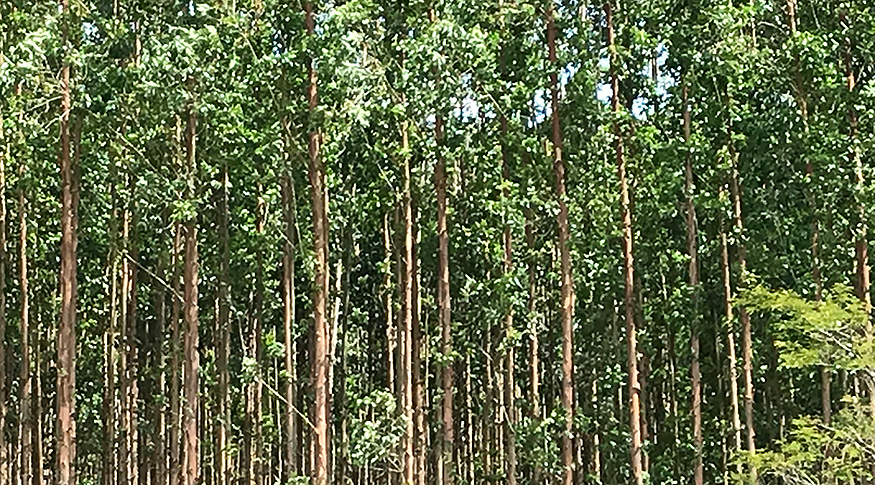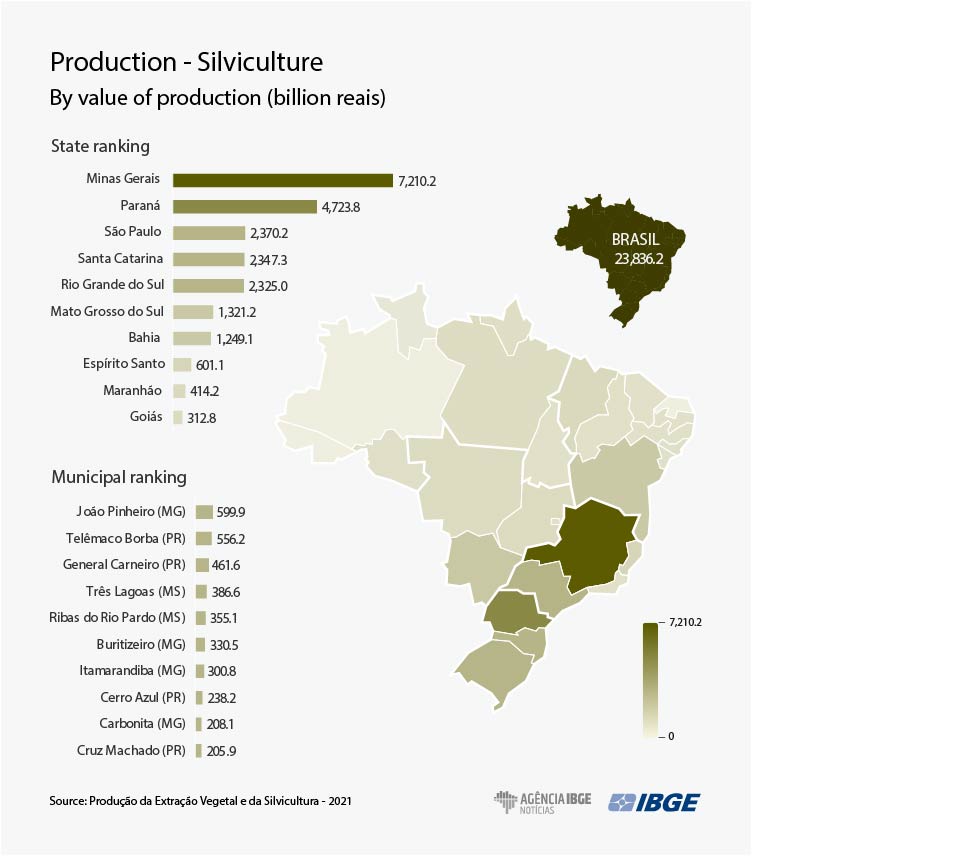PEVS
Value of forestry production increases by 27.1% and hits a record R$30.1 billion
September 29, 2022 10h00 AM | Last Updated: September 30, 2022 10h02 PM
Highlights
- Value of silviculture (planted forests) production increased by 26.1% and reached R$23.8 billion. As for forestry, value of production grew by 31.5% in 2021, and amounted to R$6.2 billion.
- Areas with planted forests dropped 1.4%, by a total 9.5 million hectares, 70.6% of which are in the South and Southeast.
- Value of production increased in alll silviculre groups, being highest in the case of logged wood (26.3%).
- Minas Gerais keeps the highest value of silviculture production, R$7.2 billion (30.2% of the value in the sector).
- João Pinheiro (MG) has the leading position in the ranking of municipalities with the highest value of forestry production in 2021, having reached R$600.0 million.
- Among the 20 municipalities with the highest forestry production figures, 16 stand out in terms of planted forest exploration, and the other four ones, of wild crop harvesting.

Value of forestry production hit a reacord R$30.1 billion, with an increase of 27.1% and production in 4,884 municipalities. Value of silviculture production is still above that of wild crop harvesting, as observed since 2000. Silviculture has been on an upward trend since 2020 (an increase of 21.3% from 2019), with an increase of 26.1%, and reached 23.8 billion in 2021.
Wild crop harvesting advanced 31.5% and reached R$6.2 billion a value of production. Data come from the survey of Forestry Activities (PEVS) 2021, released today (29) by the IBGE.
“Forestry products increased significantly in value in 2021. That has to do with the rise of the dollar and to the resumption of industrial production. The most significant increase was that of value of forestry production (27.1%). Most of that (79.3%) comes from silviculture, or planted forests, whereas wild crop harvesting accounts for 20.7%,” says Carlos Alfredo Guedes, manager at the IBGE’s Agriculture department.
He explains that silviculture’s participation in value of production of the sector increases every year, opposite to that of wild crop harvesting. That does not mean wild crop harvesting has been reduced, but that silviculture products have a higher value. “However, in 2021, in proportional terms, silviculture even fell by 0.7% in terms of value of production, whereas in wild crop harvesting there was an increase leading it to 20.7% of the total value,” Mr. Guedes explains.

In 2021, areas with planted areas in the country dropped 1.4%, about 138.9 thousand hectares. The total silviculture area amounts to 9.5 million hectares, of which 7.3 million, or 76.9% are of eucalyptus, used in the pulp industry. Together, eucalyptus and pine tree were responsible for coverage of 96.0% of the areas with planted areas for commercial purposes in the country.
The Southeast was the only Major Region with increase in planted area of silviculture, in 2021, with an increase of 30.7 thousand hectares (0.9%). The South, which has 31.9% of the areas planted with pine tree and eucalyptus in the country, recorded a decrease of 2.7%.
According to data from the Secretariat of Foreign Trade (SECEX), of the Ministry of Economy, pulp was in the ninth position in the ranking of total exports in the country in 2021 (2.4%). Brazil is the main world exporter of pulp, with 16.2 million tonnes in 2021.

The participation of wood products remains preponderant in the sector, with 95.6% of the values of forestry production. Value of production of wood products from planted areas increased by 23.7%, whereas wild crop harvesting recorded an increase of 37.9%. “These results confirm the trend to increase of wood products from silviculture and show a bigger increase of these products in 2021,” Mr. Guedes says.
Value of production increased in all the groups, being highest in logged wood (26.3%). Value of production of wood for production of pulp and paper increased by 24.4%; of charcoal, by 21.8%; of firewood, by 16.2%.
Despite the drop throughout the time series, wild crop harvesting recorded increase in the value generated in 2019 (6.9%), 2020 (6.3%) and in 2021 (31.5%). Whereas wood products account for almost the entire value of silviculture production, in terms of wild crop harvesting this group represents 63.5%, followed by food products (29.9%), waxes (4.7%), oilseeds (1.3%) and other (0.5%).
Minas Gerais has highest value of silviculture production: R$7.2 billion

Minas Gerais still keeps the highest value of silviculture production, which increased by 22.5%, and reached R$7.2 billion in 2021, or 30.2% of the total of silviculture. The state is the main producer of charcoal, with 90.0% of the national total.
Paraná is in the second position in terms of planted forests, with R$4.7 billion. It is the biggest producer of logged wood for pulp and paper, being responsible for 17.6% of the national production. Production increased 4.1%, and amounted to 15.7 million cubic meters, and value of production increased 10.0%, having reached R$1.6 billion. Logged wood for other purposes also stood out, and totaled 22.0 million cubic meters, an increase of 1.0%, which represents 37.0% of the national overall, and the state remains as the main producer in the country.
In planted area, Minas Gerais still holds the biggest area of planted forests in the country, with 2.1 million hectares, almost all of which covered with eucalyptus. São Paulo has the second biggest area of planted forests, 1.2 million hectares, of which 80.7% are of eucalyptus.
Among the 10 municipalities with the biggest areas of planted forests in Brazil, five are in Mato Grosso do Sul, three in Minas Gerais, one in Rio Grande do Sul and one in Bahia. Four municipalities in Mato Grosso do Sul are on the leading position regarding planted area in Brazil, among which Três Lagoas and Ribas do Rio Pardo stand out. both have the biggest areas of planted forests, with 237.3 thousand hectares and 196.8 thousand hectares, respectively.
João Pinheiro (MG) is the municipality with the biggest planted area in the state, fully covered with eucalyptus. In Bahia, the highlight is Caravelas, whereas in Rio Grande do Sul, Encruzilhada do Sul, with areas divided into eucalyptus and pine trees.
Paraná leads national production of firewood from silviculture
With 13.6 million cubic meters, or 26.4% of the national total, Paraná is the leader in firewood production from planted forests. Rio Grande do Sul comes next, with a production of 11.3 million cubic meters, 22.0% of the national overall. The South Region accounts for 63.3% of the national firewood production.
João Pinheiro records highest value of silviculture production
João Pinheiro (MG) recorded the highest value of silviculture production in 2021, R$600 million, being number one in the national ranking. Telêmaco Borba (PR) followed with R$556.2 million, a highlight in firewood production, with 73.0 thousand cubic meters and generating R$3.5 million, with an increase of 331.6%.
“João Pinheiro (MG) was in the second position and surpassed Telêmaco Borba (PR) in terms of value of production. That results from the demand of steel industry for charcoal produced in João Pinheiro. Telêmaco Borga, stands out due to the production of logged wood for pulp and paper production,” Mr. Guedes says.
Among the 20 municipalities in the country with highest forestry production figures, 16 had a predominance of silviculture and the other four, of wild crop harvesting. Cruz Machado (PR), besides silviculture, had as a highlight the production of yerba mate, and Limoeiro do Ajuru (PA), besides wood harvesting, stood out for harvesting of acai berry. Colniza (MT) and Prainha (PA) stood out due to logged wood.
Wild crop harvesting increases by 31.5% and generates R$6.2 billion in value of production
In 2021, value of production of wild crop harvesting increased 31.5%; it amounted to R$6.2 billion. Among the nine groups of products encompassed by forestry, oilseeds was the only one recording decrease in value of production (-2.8%).
Wood products, with the biggest participation in value of wild crop harvesting (63.5%), increased 37.9%, and reversed the trend of previous years, when wood harvesting fell in relevance and reversed the trend of the last few years, in which forestry exploration for wood was gradually replaced by production from planted forests. In 2021, many wood products recorded positive changes. Logged wood recorded an increase of 46.7% in value of production; firewood, of 10.0%; charcoal, of 30.3%. In terms of value of production, the group recorded an increase of 37.9%, and amounted to R$1.1 billion.
Mato Grosso and Pará accounted for 56.3% of the production of logged wood. Mato Grosso, which had surpassed Pará as the main producer in 2020, reached 4.5 million cubic meters, with an increase of 16.3%.
Maranhão is the main producer of charcoal, with 142.6 thousand tonnes, 32.3% of the national total, with value of production of R$ 152.7 million. In the year, production in Maranhão increased 38.2%.
Acai and yerba mate have highest value of production among non-wood products
Among non-wood products, acai berry, with R$ 771.2 million, and yerba mate, with R$ 762.9 million, are the products generating the highest production value. Among food products, acai berry, yerba mate, Brazil nut, pequi and pine nut represent 41.4%, 41.0%, 7.6%, 3.2% and 2.4%, respectively.
About the survey
PEVS 2021 presents information about area, amount produced and value of production considering the exploration of planted forests (silviculture) and of natural vegetation resources (wild crop harvesting).
Forestry encompasses 37 items, among which the highlights are: wood products, food products, waxes and oilseeds. In silviculture, seven products are investigated, including charcoal, firewood, logged wood and resin.


















